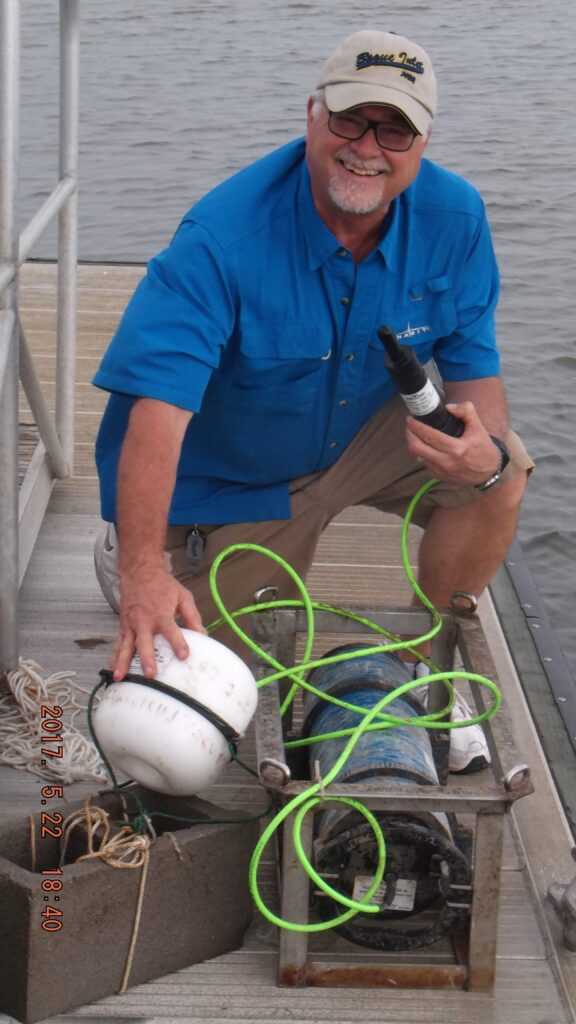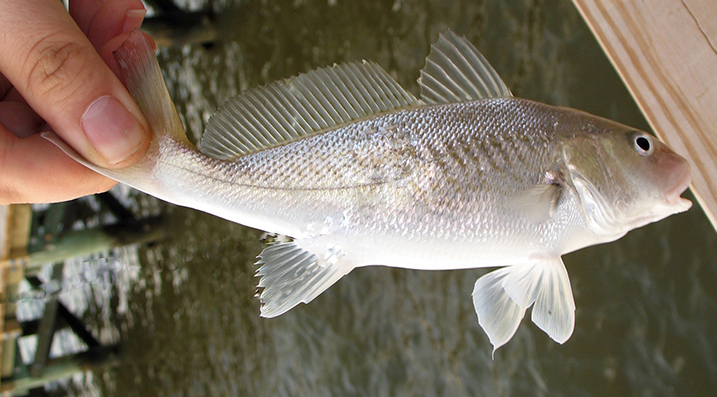Silence reveals clues about estuarine water quality.
Research Need
Nutrient pollution can degrade water quality and lead to hypoxia — when oxygen levels drop too low to support aquatic life. Prolonged periods of hypoxia negatively impact fish growth and reproduction, often with severe consequences for both recreational and commercial fisheries. Estuaries in North Carolina regularly experience hypoxia during the summer months, which can lead to fish kills and alter where fish and crabs live and gather.
Many marine organisms become stressed when oxygen levels fall below 5 milligrams of oxygen per liter of water, and lethal effects occur at levels under 2 milligrams per liter. For fish, this lethal limit is like breathing on Mount Everest without supplemental oxygen, making survival extremely challenging.
To address this, state managers have implemented plans to reduce hypoxic events through nutrient pollution control and water quality monitoring. North Carolina has defined hypoxia as oxygen levels below 4 milligrams per liter.
But how exactly do low oxygen conditions affect fish reproduction and movement? Will fish return to an area after oxygen levels are restored to normal?

What did they study?
A research team developed an underwater buoy system that simultaneously recorded fish sounds and water quality data to test whether low oxygen levels reduce fish reproductive calls. Researchers deployed this system at two high-salinity sites near Beaufort, North Carolina, where hypoxia was absent, and at one low-salinity site in Pamlico Sound, NC, which experienced periodic hypoxia. The team selected these sites based on the well-documented presence of drum fishes, like red drum and weakfish.
Additionally, the team placed passive acoustic recorders near established water quality monitoring stations to compare fish sounds with dissolved oxygen levels. This second approach also tested whether passive acoustic monitoring could effectively track changes in fish calls related to water quality across the estuary.
Listen to the sound of red drum calls at normal oxygen levels:
What did they find?
At the two high-salinity sites, dissolved oxygen levels exceeded 10 milligrams of oxygen per liter of water, indicating that hypoxia did not occur. Acoustic recorders captured sounds of silver perch, Atlantic croaker, spotted seatrout, and oyster toadfish at these locations. In contrast, at the low-salinity site, weakfish calls were initially recorded alongside oxygen levels of about 8 milligrams per liter.
However, oxygen levels fluctuated during the study, dropping to as low as 2.5 and 0.9 milligrams per liter. As oxygen levels declined, weakfish calls also diminished. When oxygen levels recovered above 4 milligrams per liter, weakfish calls resumed, though at lower levels than before the hypoxic event.
What else did they find?
By comparing fish sounds with oxygen levels from long-term monitoring stations, the research team found a strong link between low oxygen levels and reduced fish sounds, particularly in red drum. At stations with normal oxygen levels, red drum calls were clear, consistent with their expected spawning behavior.
However, at hypoxic sites, only faint Atlantic croaker sounds were detected, even though red drum were expected to be spawning at that time.
The reduced sound production at hypoxic sites suggests that fish were either farther from the acoustic recorder, calling less frequently or intensely, or avoiding the area altogether due to low oxygen levels.
So what?
The decline in sound production from species like weakfish and red drum could serve as an early warning of more severe hypoxic events, which can lead to fish kills. The researchers recommend incorporating acoustic recorders at water quality monitoring stations to better track changes in fish reproductive calls.
Reading
Luczkovich, J. J., Sprague, M. W., & Paerl, H. W. (2024). Bottom water hypoxia suppresses fish chorusing in estuaries. The Journal of the Acoustical Society of America, 155(3), 2014–2024. https://doi.org/10.1121/10.0025289
This project was funded by a grant from NOAA/ University of New Hampshire Cooperative Institute for Coastal and Estuarine Environmental Technology, NOAA Grant No. NA04NOS4190109. Funding for the UNC ModMon program included North Carolina Department of Environmental Quality (NCDEQ) (Division of Water Resources, DWR), The National Fish and Wildlife Foundation (NFWF), the Lower Neuse Basin Association (LNBA), Neuse River Compliance Association (NRCA), and UNC Collaboratory.
BY MADELINE PAYNE.
Lead photo credit: NOAA.
The text from Hook, Line & Science is available to reprint and republish at no cost, but only in its entirety and with this attribution: Hook, Line & Science, courtesy of Scott Baker and Sara Mirabilio, North Carolina Sea Grant

- Categories:




